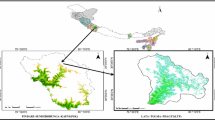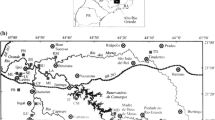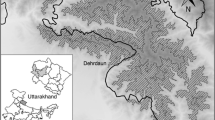Abstract
A critical first step in establishing biosphere reserves—under the Man and Biosphere Programme of UNESCO—is to generate baseline information for future courses of action. The present study aims to assess the structure and composition of forests—along with anthropogenic pressures mounting on these forests in the buffer zone of one such biosphere reserves—the Pachmarhi biosphere reserve of India. The quadrat method was employed for sampling vegetation, and information on anthropogenic pressures was collected by conducting interviews with local people and forest officials and collecting it from secondary sources. A total of 39 tree species were sampled in 82 quadrats; of these 26 tree species were in standing stage, 25 in sapling, and 35 in seedling. Chloroxylon swietenia emerged as the most dominant tree species having highest importance value index, followed by Tectona grandis, Terminalia tomentosa, and Hardwickia binata. Nine tree species and their saplings, including Sterculia urens and Terminalia arjuna, were exploited so badly that they were only found in the seedlings stage. The unavailability of standing trees of 12 important tree species including Aegle marmelos and Phyllanthus emblica indicates the intensity and gravity of anthropogenic pressures on these important tree species. If the present anthropogenic pressure continues, which has inhibited the regeneration of several tree species, then substantial negative ecological and societal consequences can be expected.

Similar content being viewed by others
References
Armesto JJ, Pickett STA (1985) Experiments on disturbance in old-field plant communities: impact on species richness and abundance. Ecology 66:230–240
Brooks TM, Mittermeier RA, da Fonseca GAB, Gerlach J, Hoffmann M, Lamoreux JF, Mittermeier CG, Pilgrim JD, Rodrigues ASL (2006) Global biodiversity conservation priorities. Science 31(5783):58–61
Clement CR, Junqueira AB (2010) Between a pristine myth and an impoverished future. Biotropica 42:534–536. doi:10.1111/j.1744-7429.2010.00674.x
Duchok R, Kent K, Devi A, Khumbongmayum Paul A, Khan ML (2005) Population structure and regeneration status of medicinal tree Illicium griffithii in relation to disturbance gradients in temperate broad-leaved forest of Arunachal Pradesh. Curr Sci 89(4):673–676
EPCO (2001) Pachmarhi biosphere reserve. Environmental Planning & Co-ordination Organization, Bhopal
Haines HH (1916) Descriptive list of trees, shrubs and economic herbs of the southern circle central provinces. Pioneer Press, Allahabad
Jayson EA (1990) An ecological survey at Satpura national park, Pachmarhi and Bori sanctuaries, Madhya Pradesh. Indian J For 13(4):288–294
Kala CP (2011a) Traditional ecological knowledge, sacred groves and conservation of biodiversity in the Pachmarhi biosphere reserve of India. J Environ Prot 2(7):967–973. doi:10.4236/jep.2011.27111
Kala CP (2011b) Indigenous uses and sustainable harvesting of trees by local people in Pachmarhi biosphere reserve of India. Int J Med Aromat Plants 1(2):153–161
Kala CP (2012) Traditional ecological knowledge and conservation of ethnobotanical species in buffer zone of Pachmarhi biosphere reserve. Indian Institute of Forest Management, Madhya Pradesh
Kala CP (2013a) Harvesting and supply chain analysis of ethnobotanical species in the Pachmarhi biosphere reserve of India. Am J Environ Prot 2:20–27
Kala CP (2013b) Traditional ecological knowledge on characteristics, conservation and management of soil in tribal communities of Pachmarhi biosphere reserve, India. J Soil Sci Plant Nutr 13(1):201–214
Kala CP, Dubey Y (2012) Anthropogenic disturbances and status of forest and wildlife in the dry deciduous forests of Chhattisgarh state in India. J For Res 2(1):45–52. doi:10.1007/s11676-012-0219-7
Karanth KK, Curran LM, Reuning-Scherer JD (2006) Village size and forest disturbance in Bhadra wildlife sanctuary, Western Ghats, India. Biol Conserv 128(2):147–157. doi:10.1016/j.bbr.2011.03.031
Majila BS, Kala CP (2010) Forest structure and regeneration along the altitudinal gradient in the Binsar Wildlife Sanctuary, Uttarakhand, India. Russ J Ecol 41(1):75–83. doi:10.1134/S1067413610010157
McNeely JA (1994) Lessons from the past: forests and biodiversity. Biodivers Conserv 1:3–20
Misra R (1968) Ecology work book. Oxford and IBH Co, New Delhi
Mitchell FJG, Kirby KJ (1990) The impact of large herbivores on the conservation of semi-natural woods in the British uplands. Forestry 6(4):333–353
Myers N, Mittermeier RA, Mittermeier CG, Da Fonseca GA, Kent J (2000) Biodiversity hotspots for conservation priorities. Nature 40(6772):853–858
Oommachan M, Bajaj A, Masih SK (1990) Ethnobotanical observations at Pachmarhi Madhya Pardesh. J Trop For 2:157–161
Prasad R, Kotwal PC, Mishra M (2001) Impact of harvesting of Emblica officinalis (Aonla) on its natural regeneration in central Indian forests. J Sustainable For 14(4):1–12
Rapport DJ, Costanza R, McMichael AJ (1998) Assessing ecosystem health. Trends Ecol Evol 13(10):397–402
Richards PW (1996) The tropical rainforest: an ecological study. Cambridge University Press, Cambridge
Roy GP, Shukla BK, Datta B (1992) Flora of Madhya Pradesh. Ashish Publishing House, New Delhi
Somanathan H, Borges RM (2000) Influence of exploitation on population structure, plant spacing and reproductive success in dioecious tree species within a fragmented cloud forest in India. Biol Conserv 94:243–256. doi:10.1016/S0006-3207(99)00170-6
Witt DO (1916) Descriptive list of trees, shrubs, climbers and economic herbs of the northern and berar forest circles central Provinces. Pioneer Press, Allahabad
Acknowledgments
I thank the director of the Indian Institute of Forest Management, for his help and support. Diksha Bhandari is acknowledged for helping in collection of field data. The author thanks two anonymous reviewers for improving the earlier drafts of the manuscript. The project was under the Grant IIFM/RP-Int./CPK/2009-11/04.
Author information
Authors and Affiliations
Corresponding author
Additional information
Project fund: This study was funded under the grant IIFM/RP-Int./CPK/2009-11/04.
The online version is available at http://www.springerlink.com.
Corresponding editor: Chai Ruihai.
Rights and permissions
About this article
Cite this article
Kala, C.P. Forest structure and anthropogenic pressures in the Pachmarhi biosphere reserve of India. J. For. Res. 26, 867–874 (2015). https://doi.org/10.1007/s11676-015-0083-3
Received:
Accepted:
Published:
Issue Date:
DOI: https://doi.org/10.1007/s11676-015-0083-3




